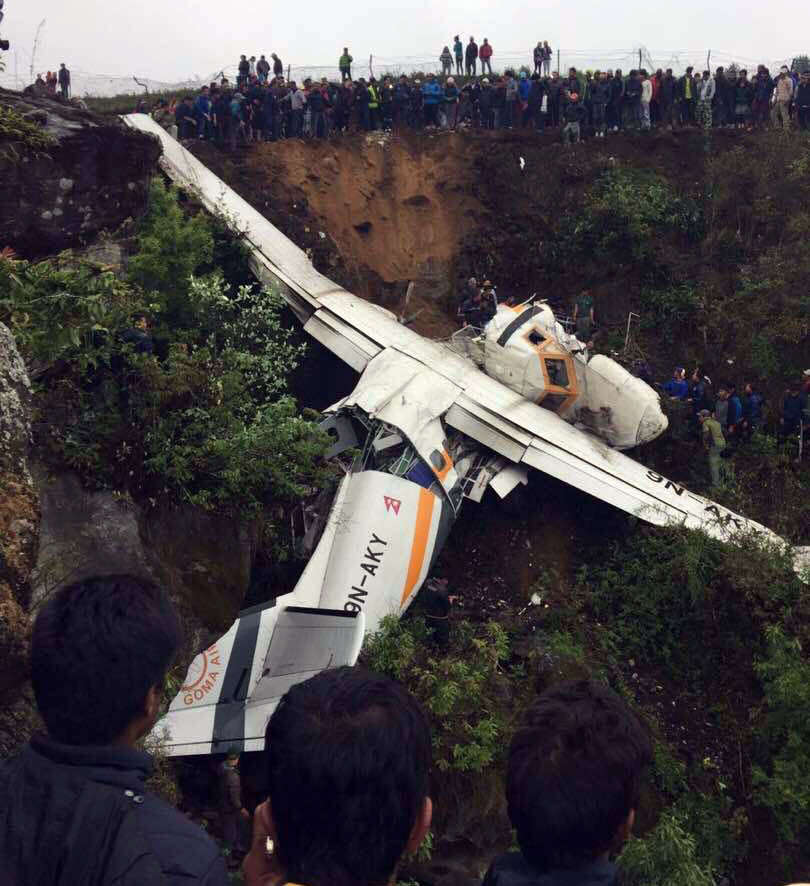Pinning blame on dead pilots can’t improve air safety: Experts
Kathmandu, December 18
Sheer ignorance of the government-proclaimed air crash investigation experts has come to light once again and there is no possibility of bringing air safety improvements at Lukla Airport in the Mt Everest region in the near future, if the latest investigation report of the fatal Goma Air Let-410 crash is anything to go by, stakeholders have claimed.
While comically blaming bad weather as the proximate cause for the crash that resulted in the loss of two flight crew members on May 27, investigators have yet again tried to shield the negligence and indifference of air safety inspectors at Civil Aviation Authority of Nepal who are responsible for ensuring compliance with International Civil Aviation Organisation standards on aircraft operations, according to them.
The ICAO annex clearly places the onus of the safety of flight on both the pilot in command as well as the flight dispatcher — a licensed person who is engaged in the control and supervision of flight operation and supports the pilot-in-command in the safe conduct of the flight. The annex states, inter alia, one of the key responsibilities of the dispatcher is to furnish the pilot-in-command while in flight, by appropriate means, with information which may be necessary for the safe conduct of the flight.
Clearly, the dispatcher must have communication access to the flight deck in all phases of flight, a facility that has been wilfully ignored by the air safety regulator for long and is lacked by even the operators while the safety audit findings on this score have remained open for decades now, an airline official conceded.
“Thus by pinning the blame on dead pilots who cannot defend themselves, the commission has blatantly tried to manipulate the truth, which is a detriment to air safety in Nepal,” a senior pilot commented.
Unveiling the report, members of the probe panel, however, mentioned that they found the pilot’s loss of situational awareness to cope with the deteriorating weather condition and improper response of the pilot to stall warnings,
failure to advance power lever to maximum at appropriate time and violation of Standard Operating Procedures by the Air Traffic Service and the pilot as the major factors for the crash.
Besides, the probe commission headed by the former CAAN director general has also tried to shield the weaknesses on the part of the aerodrome operator, the CAAN, which was responsible for maintaining the meteorological conditions observation equipment that had remained unserviceable for months, he added.
The commission’s logic that a VFR flight does not need an altimeter setting from the landing aerodrome are contrary to ICAO provisions and reek of utter lack of comprehension of aircraft operations by all on board the commission, another senior captain agreed. “Otherwise why are the equipment installed in the first place, and post-Lukla crash, numerous Aeronautical Information Publication supplements warn of the lack of serviceability of identical equipment at other remote airports like Dolpa, Phaplu, Rumjatar which only support VFR flights?”
The ICAO annex on crash investigation also requires documentation on the adequacy of the evacuation and rescue efforts, where again the CAAN failed miserably in its duties and had it not been for the miraculous presence of trained medics from New Zealand and the USA, then, the extrication of the flight crew members from the wreckage would have been awful, aviation experts shared. “The investigation report is curiously silent on this issue, too, and provides no recommendation for future preparedness but strangely talks of extending the runway a further 100 feet as if it would adequately mitigate hazards associated with aircraft operations at airstrips with upward slopes leading to visual illusions, a phenomenon adequately documented by ICAO.”
Perhaps, that is why the Asian Development Bank had attempted to install an A-PAPI, a visual guidance system in 2013 in the name of air safety improvement, but CAAN’s ineptness failed to make it operational, they concluded.
READ ALSO:






